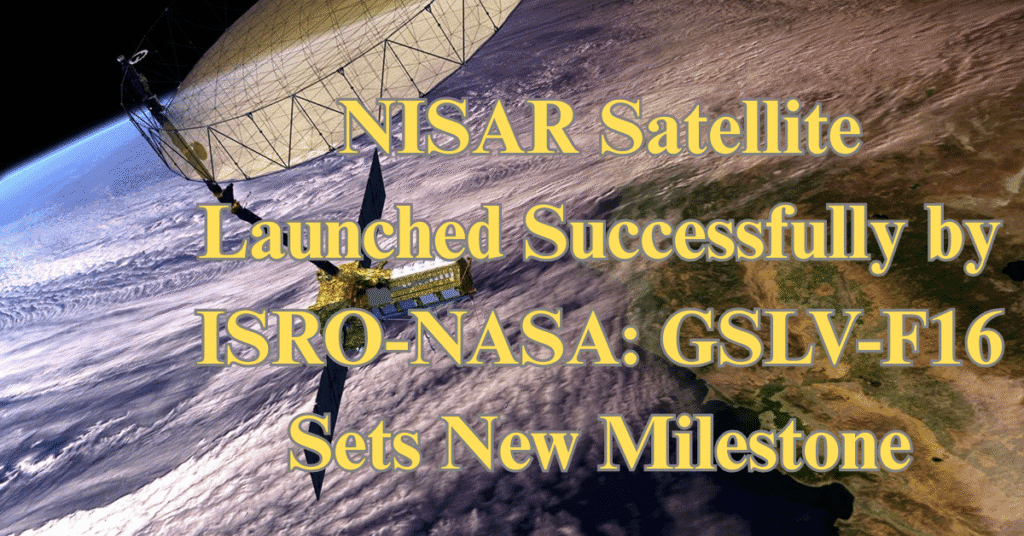
Table of Contents
NISAR Satellite
NISAR Satellite : In a remarkable milestone for international space collaboration, the Indian Space Research Organisation (ISRO) and the National Aeronautics and Space Administration (NASA) successfully launched the NISAR (NASA-ISRO Synthetic Aperture Radar) Earth observation satellite on Wednesday, July 30, 2025, at 17:40 hrs IST from the Satish Dhawan Space Centre, Sriharikota, Andhra Pradesh.
This momentous mission not only showcases the strength of Indo-US cooperation in space science but also marks a significant achievement in India’s space launch capabilities.
NISAR Satellite
🚀 A Decade-Long Mission Worth Over $1.5 Billion
The NISAR project, over ten years in development, is one of the most ambitious Earth observation satellite missions ever attempted. Backed by a combined investment exceeding $1.5 billion, the satellite is designed to monitor Earth’s surface changes with unmatched precision.
The radar technology aboard NISAR will help track changes in land ecosystems, ice sheets, and natural disasters such as earthquakes, landslides, and volcanoes. The satellite will offer high-resolution, all-weather, day-and-night imaging of Earth, providing critical data for climate change, agriculture, and disaster management.
NISAR Satellite
🔭 What Is NISAR and Why Is It Important?
NISAR stands for NASA-ISRO Synthetic Aperture Radar. It is a cutting-edge Earth observation satellite equipped with dual-frequency radar systems—L-band radar provided by NASA and S-band radar built by ISRO.
Key Features of NISAR:
- Dual-band radar (L and S bands) for global land surface imaging
- High-resolution imagery with sub-meter accuracy
- All-weather, day-and-night observation capability
- Applications:
- Monitoring glacial melting and sea-level rise
- Earthquake and volcano risk assessment
- Forest carbon tracking and agricultural planning
- Infrastructure stability monitoring (e.g., dams, roads, buildings)
🌍 GSLV-F16: A New Chapter in Indian Rocketry
The Geosynchronous Satellite Launch Vehicle – F16 (GSLV-F16) achieved a historic first by placing the NISAR satellite into a sun-synchronous polar orbit—a mission profile typically reserved for the Polar Satellite Launch Vehicle (PSLV).
This is the first time in Indian space history that a GSLV has successfully executed a launch into a sun-synchronous orbit. This development marks a critical evolution in ISRO’s capability to use heavier launch vehicles for diverse mission profiles.
GSLV-F16 Key Highlights:
- Launch Site: Satish Dhawan Space Centre, Sriharikota
- Orbit: Sun-synchronous polar orbit
- Payload: NISAR satellite
- Mission Time: 17:40 hrs IST on July 30, 2025
This not only diversifies ISRO’s launcher capabilities but also strengthens its ability to undertake future interplanetary missions and heavy-payload deliveries.
🤝 Strengthening Indo-US Space Collaboration
The success of NISAR is a powerful symbol of growing Indo-US cooperation in advanced science and technology. Both agencies brought their unique strengths to the table—NASA contributed the L-band radar, communications systems, and engineering expertise, while ISRO provided the S-band radar, satellite bus, and launch vehicle.
This mission cements the long-standing partnership between the two nations and lays a solid foundation for future collaborative space ventures.
🔮 What’s Next After NISAR?
With the successful deployment of NISAR, the satellite will now undergo orbit calibration and instrument testing before beginning its operational phase. Once operational, it will start delivering high-volume scientific data that will be made available to researchers and agencies globally.
The data collected will play a pivotal role in understanding Earth’s dynamics, forecasting natural disasters, and shaping climate and agricultural policy.
ISRO #NASA #NISAR #GSLVF16 #EarthObservation #SatelliteLaunch #SpaceNews #ClimateChangeMonitoring #IndianSpaceMission #USIndiaPartnership #ISROLive #NASAIndiaCollaboration #SpaceInnovation #GeoScience
🛰 Conclusion: A Giant Leap for Global Earth Science
The successful launch of the NISAR satellite using GSLV-F16 is a landmark achievement in Earth science, engineering, and international cooperation. For ISRO, it marks a breakthrough in rocket versatility; for NASA, it exemplifies the value of global partnerships. For the world, it opens a new era of real-time, high-resolution, climate and disaster monitoring from space.
As India and the United States continue to collaborate in space exploration, missions like NISAR reaffirm that the sky is not the limit—it’s just the beginning.


